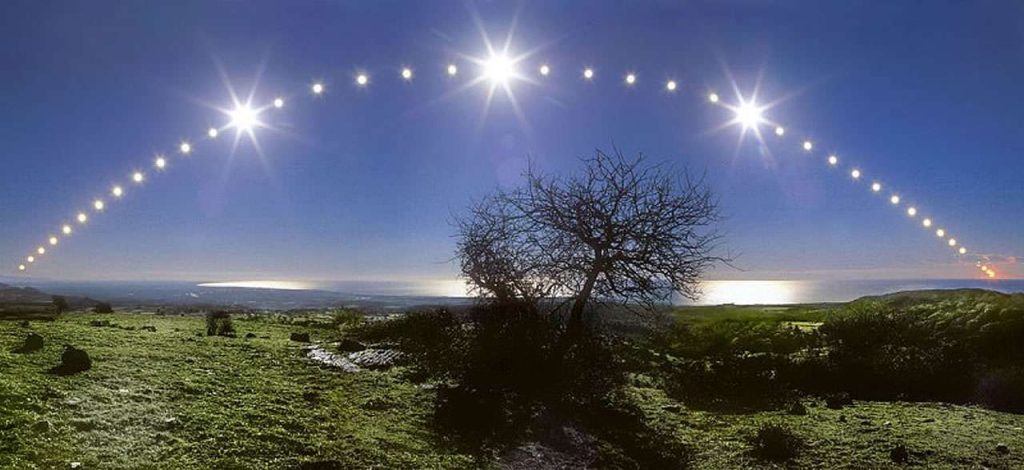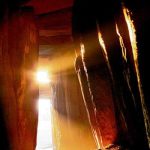
Winter Solstice is also known as: Alban Arthan (Welsh), Yule/Jal (Norse), Christmas (Christian), Saturnalia (Roman)
Usually celebrated on 21st or 22nd December (Northern Hemisphere)
What is the Winter Solstice?
The winter solstice is the shortest daylight and longest night of the year. The time when the Sun reaches the furthest South in its point of rising and its lowest maximum elevation in the sky. After the winter solstice the days begin to lengthen again and the Sun slowly starts to regain its strength. Many cultures recognise this as a time of rebirth; a time to celebrate with festivals, gatherings & rituals.
The Culture of the Solstices
Monuments that are aligned to the summer solstic are also aligned the winter solstice, they cannot be anything else. The sun’s vertical rays strike the Tropic of Cancer, 23.5° north of the Equator, during the June solstice. The subsolar point then begins its migration south. And vertical rays strike the Tropic of Capricorn, 23.5° south of the Equator, during the December solstice.
We now celebrate four seasons. So we view the solstices as marking the beginning of summer and the beginning of winter. And we relate the equinoxes to spring and autumn.
Ancient cultures tended to only recognise two seasons; summer and winter. When the days become longer than the nights (Spring Equinox) it signals the start of the light half of the year; aka summer. When the nights become longer than the days (Autumn Equinox), it signals the start of the dark half of the year; aka winter. The equinoxes are the marking points for the light and dark halves of the year; summer and winter.
The two solstices occur approximately midway between the two equinoxes. This means that they occur roughly in the middle of the season and for this reason are also known as Midsummer and Midwinter. The point of roughness is the term for the winter solstice in Wales. An article which looks at this in more depth is available at the National Geographic.
Solstice
Originally featured on BBC Radio Scotland on December 21, 1985. Listen and ‘Stretch Out Your Hand’
GDPR Compliant
Solstice Alignments of the ‘Stones’
Newgrange
One of the better known Neolithic sites is Newgrange, Eire. At sunrise, on the shortest day of the year, direct sunlight enters the Newgrange monument. Not through the doorway, but through the specially contrived small opening above the entrance known as the ‘roof box’. This creates the striking effect of illuminating the Chamber. The dramatic event lasts for 17 minutes at dawn from the 19th to the 23rd of December.

Bryn Celli Ddu, Ynys Mon (Anglesey).
Similar in scope to Newgrange is Bryn Celli Ddu, Ynys Mon (Anglesey). The name translates to ‘The Mound in a Dark Grove’ in English.
“The Bryn Celli Ddu passage mound does not have a ‘light-box’ per se, but it does have a sophisticated means of measuring the year incorporated into its design. Using the entry of light into the passage at certain times, in a similar way as seen with light-boxes elsewhere in UK.
At Bryn Celli Ddu, the passage-mound was designed in such a way so that the light of the sun at relevant times of the year would penetrate the chamber. This would cause a beam of light to be cast on a ‘Declination Gauge’ made by the tall, cylindrical pillar placed at the back of the hexagonal chamber. The changing altitude of the sun over the year causes the light of the sun that reaches the inside of the chamber to move up and down the pillar over the year. Notches have been found which support this theory. At the winter solstice, the dagger of sunlight would have reached the top of the pillar but for a concrete lintel recently placed to secure the roof.” You can find full information on Bryn Celli Ddu on the Ancient Wisdom website.
Maeshowe (Orkney)
Maeshowe is a Neolithic chambered tomb situated on Orkney which is an archipelago off the northeastern coast of Scotland. At the ‘Heart of Neolithic Orkney’ is a group of 5,000-year-old sites on Mainland, the largest island. Including Skara Brae, a preserved village with a reconstructed house, and Maeshowe, a chambered burial tomb incorporating 12th-century Viking carvings.
Maeshowe’s longstanding connection to the Winter Solstice stems from the natural phenomenon of the setting midwinter sun; shining directly down the passageway from the site’s entrance and illuminating the back wall of the tomb with beautiful, bright light. This is captured in a film that Historic Environment Scotland made in 2021 to celebrate the annual event.
GDPR Compliant
Winter Solstice Energies
The Sun has been growing weaker and weaker and the daylight hours shorter and shorter until the Winter Solstice arrives.The Sun is now at its weakest and shines for its shortest period. At Solstices the Sun appears to stand still (the word solstice is derived from two Latin words ‘Sol’ – Sun and ‘Sistere’ – to cause to stand still). Rising at the same Easterly point on the horizon, taking an identical arc across the sky and setting at the same Westerly point for several days. After which it slowly starts its Journey back, getting stronger, shining for longer and reaching a higher elevation each day.
This is what causes it to be viewed as a time of rebirth; the Sun of the old year has died and at Winter Solstice it is reborn, to grow anew. Truly a time for celebration, to celebrate the coming of the light. The midwinter sunset at the winter solstice marks this; as the Sun sets, it dies. This may have been of much greater importance than the Summer Solstice.
Midwinter Sunset
The Solstices are probably the oldest seasonal festivals of humankind; important to many ancient cultures.
“For the people of Stonehenge who were farmers, growing crops and tending herds of animals, knowing when the seasons were changing was important. Winter might have been a time of fear as the days grew shorter and colder. People must have longed for the return of light and warmth. Marking this yearly cycle may have been one of the reasons that Neolithic people constructed Stonehenge. A monument aligned to the movements of the sun. The stones were shaped and set up to frame at least two important events in the annual solar cycle – the midwinter sunset at the winter solstice and the midsummer sunrise at the summer solstice.” English Heritage
GDPR Compliant
Winter Solstice Folk-Lore Customs and Traditions
Fire played an important role in the practices of our ancestors, it was both a form of sympathetic magic; mimicking the Sun and encouraging it to return. Fire is also seen as having a protective capability; it wards off unseen entities found in the dark.
Yule
Yule, or Jol, was the name of the midwinter festival of the pagan Norse and Teutonic people of northern Europe. From the 8th century onwards, as the Norwegians settled in Orkney and Shetland, they carried their Yule festival with them. A festival celebrated for centuries. In the Northern Isles, Yule lasted about a month – a period referred to as “the Yules” or “atween the Yules”. https://www.orkneyjar.com/tradition/yule/index2.html
The Yule Log; a large log known as the Yule log would be burnt on the fire at the Winter Solstice. If the Yule log was kept burning bright for the twelve days that the Sun was thought to stand still for, then it (the Sun) would be persuaded to move again. This would make the days grow longer and good fortune would ensue. If a Yule Log went out, then there would be terrible luck. The remains of the log were kept to light the next years log.
Decorations for the Winter Solstice
The Holly & The Ivy
Decorating with greenery was a common practice.To our Brythonic ancestors evergreens in winter were symbolic. They provided a home over the cold months for good spirits (fae folk) and the prickly nature of holly protected against the bad ones. It was the Ivy and holly’s evergreen nature that made it special. They would decorate doorways with it in the hopes that it would capture any bad spirits before they could enter the house, (flypaper for bad fairies?). Traces of evergreen branches have been found in several Neolithic sacred sites as well as the excavations of older private dwellings.
Mistletoe
Considered to be a sacred plant, Misletoe was believed to have all sorts of miraculous qualities. The power of healing diseases. Making poisons harmless. Giving fertility to humans and animals. Protecting from witchcraft, banning evil spirits, bringing good luck and great blessings. From this old custom grew the practice of suspending Mistletoe over a doorway or in a room, as a token of good will and peace to all comers.
Twelfth Night Customs
Twelfth night; the end of the 12 days of burning the Yule log, was the traditional time for further activities.
Wassailing
This ceremony originally took place around the oldest tree in the apple orchard. The first cider crop; made from the apples harvested from the orchard was poured on the roots of the apple tree. This was both to thank the tree spirits for the crop of apples, and to ensure a good harvest next year. Drumming and banging sticks would beat away any bad spirits, and the wassail cup would be passed around. Toast dipped in cider would then be hung on the oldest tree, as an offering to the tree spirits. Our main references for this custom come from the later period; after the Romans had vacated, but before Christianity. ‘Wassail’ was a Saxon word meaning ‘good health’.
Mari Lwyd
The Mari Lwyd is a custom that still exists in Wales and Cornwall as a tourist attraction on New Year’s Day or Twelfth Night. In English it translates to ‘Old Grey Mare’

A horse skull is decorated with ribbons, cloth flowers, bottle-glass eyes and trinkets. It is carried from house to house while participants sing bawdy songs, tell bad puns, and perform a rambunctious dance. Often a Mari has a skirt for the operator to hide beneath. This makes the skull appear animated, and the songs and puns are attributed to the dead horse. Sometimes a candle is burned inside the skull. The procession often culminated at the village tavern. This practice is thought to be historically Pagan and probably originated in ancient times as a tribute to the personification of Death. Or possibly as laughing in the face of death.
To understand how these celebrations came about and what they are check out Sacred Celebrations